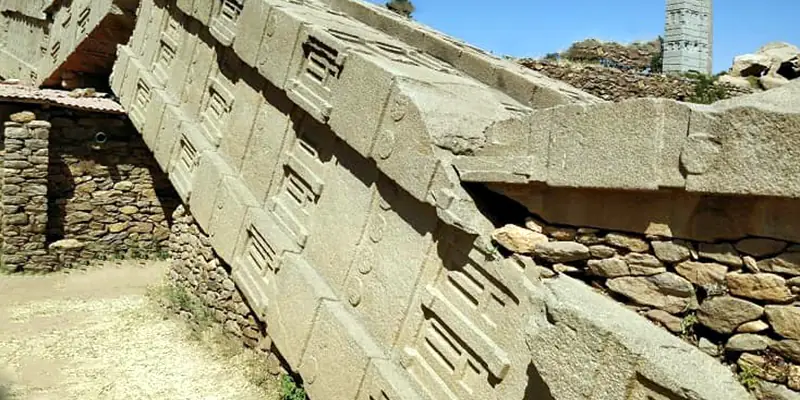Early African Civilizations History
The Kingdom of Aksum Overview
The Kingdom of Aksum Overview. Aksum ruled from the first century BCE to the seventh century CE in what is now Ethiopia and Eritrea. This powerhouse was formed not through brute force but through smart trading. Aksum, located along key routes connecting Africa and Rome, grew into a busy market for ivory, gold, and spices. This trading expertise, along with astute political maneuvering, drove Aksum’s climb to imperial greatness. Furthermore, let’s look into Aksum’s fascinating world and learn about its incredible history, impressive achievements, and lively culture.
Table of Contents

Kingdom of Aksum History
Aksum’s story stretches far back into history, with its roots firmly planted in the Semitic-speaking people of Ethiopia. What propelled this kingdom to greatness was its strategic location along the Red Sea. As a result, this provided a gateway to trade with neighboring regions like ancient Egypt, Arabia, and the Roman Empire. With control over vital trade routes, Aksum amassed great wealth and became a dominant force in the ancient world.
Kingdom of Aksum Culture
The Kingdom of Aksum was a cultural melting pot that developed a distinctive identity through its written language, art, and architecture. Ge’ez, the intricate written script of Aksum, was the foundation of a thriving literary tradition that produced epic poems about heroes and religious texts. Furthermore, this unique writing system sets Aksum apart from other cultures.
In addition to its literary achievements, Aksum was known for its art and architecture. The murals and sculptures depicted daily life and myths in a visually captivating way. The Great Enclosure, a stunning building that combined Egyptian influences with local styles, was a testament to the skill of Aksum’s builders. Aksum, as a center of trade, received a variety of cultural influences, including those from Greece, Rome, and India. These external ideas woven into Aksum’s culture shaped its art, architecture, and laws.
Despite the influence of outside cultures, Aksum maintained its own vibrant identity. The artifacts that have been unearthed provide a glimpse into the rich tapestry of Aksum’s culture. Through blending external ideas with internal traditions, the Kingdom of Aksum created a unique cultural legacy that has stood the test of time.
Religion of Aksum
Aksum is a fascinating kingdom that played a significant role in the spread of Christianity in Africa. What’s even more interesting is that it was one of the first African kingdoms to embrace Christianity as its state religion. This adoption is credited to the conversion of King Ezana in the 4th century CE. Since then, the Kingdom of Aksum has become a crucial hub for the expansion of Christianity on the continent. Even today, people can observe remnants of this religious heritage in the numerous churches and monasteries that grace the stunning landscape of modern-day Ethiopia.
Kingdom of Aksum Art and Literature
Aksumite art is notable for its distinct style and superb craftsmanship. Their skill may be seen in the beautiful stone carvings, bronze statues, and pottery adorned with religious symbolism and geometric designs that have withstood the test of time. Furthermore, the Aksumites left a rich legacy of oral literature, which included intriguing tales, fables, and legends passed down from generation to generation.
Kingdom of Aksum Achievements
The Kingdom of Aksum was a dynasty of innovation, leaving behind enduring legacies that reflect their power. Towering obelisks, some reaching a staggering 100 feet, dotted the landscape. These engineering marvels were more than merely structures; they were also representations of the Aksumites’ might and religious convictions, adorned with remarkable sculptures that related to their spiritual beliefs.
The Aksumites were not content with just building grand monuments. Most importantly, they minted their own gold and silver coins, known as “Aksumites,” which allowed them to conduct internal trade and project their economic influence beyond their borders. This forward-thinking approach to currency was just one of the many ways in which the Kingdom of Aksum established itself as a dominant force in the region.
Moreover, Aksum did not limit its innovations to material achievements. In the 4th century CE, the kingdom underwent a spiritual transformation by adopting Christianity. Subsequently, this profound conversion had a far-reaching impact on everything from art to law. It left behind churches and texts that wove Christian into Aksum’s cultural fabric for future generations.
Finally, from the colossal obelisks that proclaimed their faith to the mints that fueled their commerce, the Aksumites leveraged their pillars of innovation to expand their dominance. Their engineering accomplishments and accomplishments were in line with their enormous ambitions. Additionally, they were positioning themselves at the forefront, which would eventually sweep across the entirety of their ancient world.
Trade and Economy of the Kingdom of Aksum
Aksum’s robust trading network was one of its most amazing achievements. Based on its strategic location, the kingdom became a crossroads for trade between Africa, Asia, and Europe. Aksumites traded products such as ivory, gold, spices, and animals, bringing great prosperity to the kingdom. The Aksumite money, also known as Aksumite coinage, was one of Africa’s first examples of a standardized financial system. The Kingdom of Aksum overview in this post shows the kingdom was also innovative in money and trading systems.
Architecture and Engineering of the Kingdom of Aksum
The Kingdom of Aksum known for its impressive architectural achievements, particularly the towering obelisks that symbolized power and served as monumental markers. These massive stone structures, some towering up to 100 feet in height, shows the advanced engineering skills of the Aksumites. The most famous of these obelisks, the Obelisk of Axum, was relocated to Rome but has since been returned to its rightful place in Aksum. These magnificent monuments are a tribute to the ancient Aksum civilization’s intellect and creativity.
Decline and Legacy of the Kingdom of Aksum
Aksum may not have held onto its imperial power forever, but its legacy lives on as a shining example of African history. Its impressive accomplishments in trade, awe-inspiring architecture, and the dissemination of Christianity have left a permanent imprint on the continent. Today, wandering through the ruins of Aksum is like taking a journey back in time. The ruins offering a window into a civilization that once reigned supreme over the region and still inspire us all. The Kingdom of Aksum overview in this post shows the kingdom from the beginning and its decline.
Conclusion
This Kingdom of Aksum overview shows us the rich history and cultural heritage of the continent known today as Africa. This ancient civilization has left a permanent mark on the world, from its strategic trade networks to its impressive architectural achievements. Additionally, Aksum’s influence extends far beyond its borders, thanks to its embrace of Christianity and its vibrant artistic tradition.
Furthermore, as we looked into the history, achievements, and culture of Aksum, we gained a deeper appreciation for its fascinating African history. Studying Aksum is an exciting experience for anyone interested in African history. Moreover, let’s not forget about the vibrant artistic expressions it has gifted future generations!
We’ve gained valuable insights into the interconnectedness and contributions of African civilizations to the world at large. Finally, feel free to explore the Kingdom of Aksum on your own and all that it has to offer.
